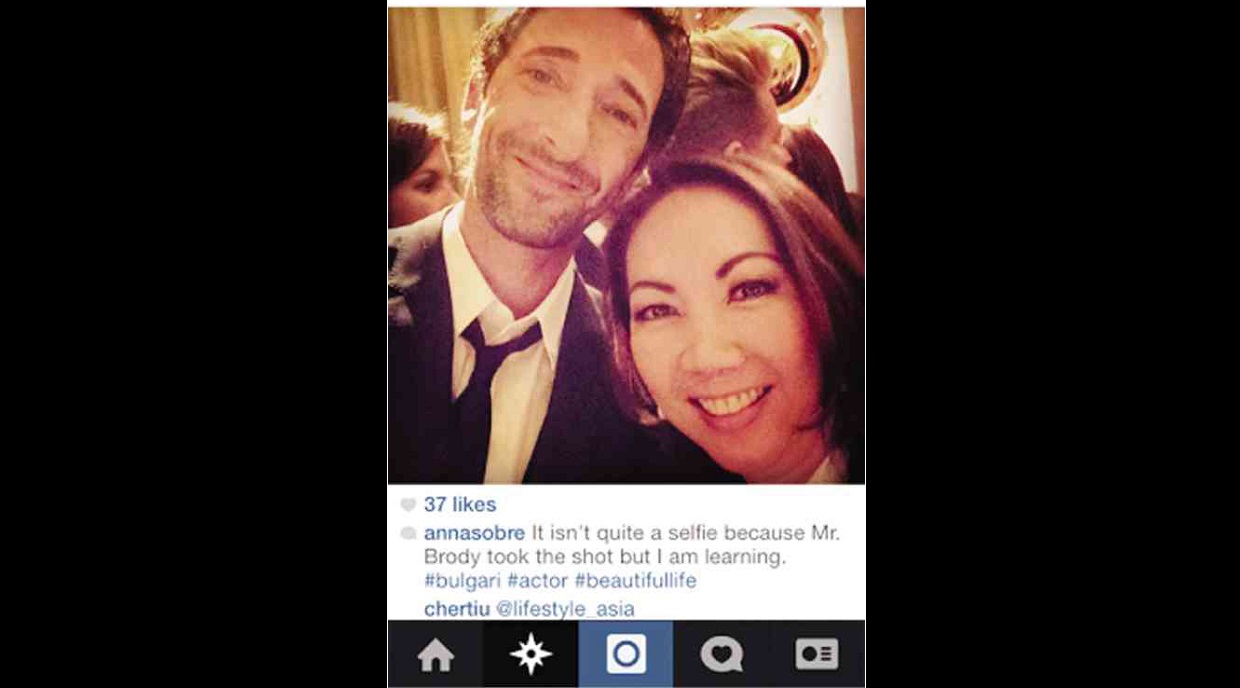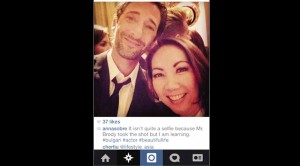
Never underestimate a starstruck editor’s capacity to chase a “scoop”—even if she’s in stilettos. (Those killer heels could really restrict one’s mobility.)
Last early spring in Rome, in a palazzo on a chilly night, to celebrate Bulgari’s 130th anniversary, I was literally cooling my heels in my hardly broken-in pumps when Anna Sobrepeña rushed to us, unable to contain her excitement.
“Adrien just took my selfie. I didn’t know how to do it, so he did,” she said, grinning from one Wynn Wynn Ong-bedecked ear to another.

Bulgari’s head in Manila, Mario Katigbak, and I didn’t believe it for a second, but then she flashed her phone before us, and yes, there it was—her lovely selfie with Adrien Brody, the Oscar Award-winning American actor (“The Pianist”). And before Anna could consume her 15 minutes of fame, we glanced sideways, and who should be standing beside us chatting with other guests? Brody himself, so casual and nondescript. No, we didn’t dare top Anna’s selfie.
It turned out that Anna, in her pretty, studded but high Valentino stilettos, was able to tail Brody around the cocktails at the palazzo. By the way, Anna is celebrating her 30th wedding anniversary with husband Chito, in solemn rites at the Minor Basilica of the Immaculate Conception.
Apart from France’s former first lady and style celebrity Carla Bruni-Sarkozy, Brody was the guest of honor at Bulgari’s celebration of its 130th year and the reopening of its refurbished historic store in Via dei Condotti.
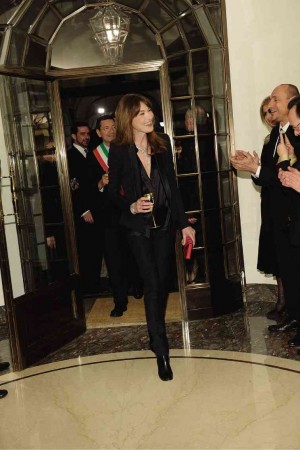
Earlier that evening, Brody, Bruni-Sarkozy, with Paolo Bulgari, Nicola Bulgari and Jean-Christophe Babin, chair, vice chair and CEO, respectively, of the Bulgari Group, led guests who massed on Via dei Condotti, doing champagne toasts, as the door to the refurbished historic store opened.
The crowd was a heady mix of royalty, film celebrities and A-list European clientele of the luxury brand. It was interesting to note that, as they gathered on the street before the door opened, the staff of the Prada store directly across the Bulgari store peered out the windows to ogle the Bulgari guests.
In the store, done by foremost American architect Peter Marino, the guests saw the awesome selection of jewelry specially designed for this milestone. Easily the jaw-dropper was the Ultimate Temptation necklace made of over 60 carats of fancy-shaped diamonds and a 12.16-carat drop.
Rome landmark
Not far from the store, the famous Rome landmark and favorite tourist destination, the Spanish Steps, were lit dramatically for the milestone event. That morning, Bulgari, through Babin, gifted the city of Rome with 1.5 million euros to help fund the renovation of this historic backdrop.
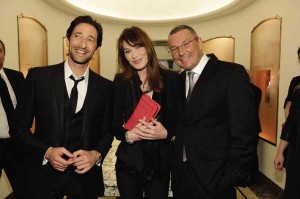
In the morning ceremony at the Rome City Hall, before Rome Mayor Ignazio Marino, Babin said of the Spanish Steps: “They are at the heart of our history, between via Sistina, where Sotirio Bulgari first opened its doors in 1884, and the historic store in Via dei Condotti. Who better than Bulgari to contribute to the renovation of such an architectural jewel in the Eternal City?”
On the world market for luxury brands such as Bulgari, Babin gave an interesting insight in an exclusive interview with Inquirer Lifestyle just before the event.
“In today’s nomadic lifestyle (when families migrate or get uprooted because of work), finding trust is very important,” he said. “Trust in the family jeweler. Bulgari is a brand that stands for trust, continuity, consistency.”
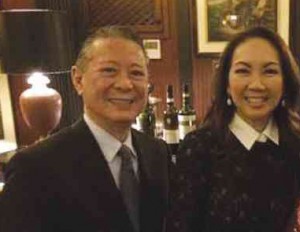
He stressed how, even amid shifting economic environments, Bulgari has strengthened its core business, which is jewelry. This top executive who came from a consumer multinational noted that “the consumer is bombarded with many messages. It’s important to understand the consumer and (to give him/her) the message that’s easy to understand. Few brands are like Bulgari that have a very strong position.”
He further stressed: “Bulgari, while creating new styles, stands for timelessness. If you guarantee timelessness, people will love you forever.”
Indispensable cog
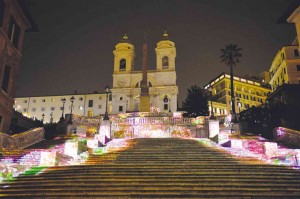
The historic Spanish Steps, Rome’s priceless jewel, is an indispensable cog in the timeline of a timeless brand that is Bulgari.
In its literature, Bulgari recalls the interesting history: “Sotirios Boulgaris was born into a family of Greek silversmiths in 1857; an exceptionally skilled and talented craftsman, he was also blessed with keen business acumen. In 1879, the search for new opportunities prompted him to leave Greece and, after a short period in Corfu and then Naples, in 1881 he settled in Rome, the capital of the newly established Kingdom of Italy.
“In 1884, as soon as his finances permitted, Sotirio opened his first shop at via Sistina 85—on the fashionable promenade leading to Piazza Trinità dei Monti at the top of the Spanish Steps—where he was to remain until 1923. In 1894 Sotirio opened a second store located at Via dei Condotti 28 and, in 1905, a third and larger one at numbers 10b and 10c of Via dei Condotti.
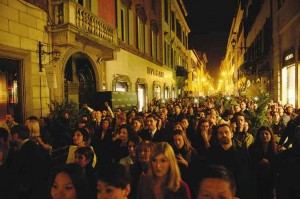
“This shop is situated at the end of the street which leads to the Spanish Steps, opposite the elegant and fashionable Caffé Greco. It is at the heart of the so-called “Tridente” complex of roads, and on one of Rome’s most glamorous shopping streets. For years the three Bulgari shops coexisted, linked by the Spanish Steps. La Scalinata di Trinità dei Monti, as this monumental stairway with its 138 travertine steps is known in Italian, was designed by Francesco de Sanctis as an interpretation of terraced garden stairs on a massive scale; it was completed in 1725, and is still to this day the widest in Europe.
“For nearly four decades, the Spanish Steps played an important functional role for Bulgari, physically connecting the shops situated below and above the hill. Surely no other jeweler in the world boasts a more spectacular architectural backdrop.”
Flagship store
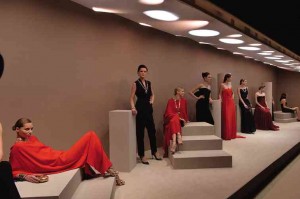
The Bulgari shop at Via dei Condotti 10, which architect Marino refurbished for the 130th anniversary celebration, was opened in 1905 by Sotirio. From the late 1920s to 1971, it was the only Bulgari shop, and is today Bulgari’s flagship store.
It occupies the ground floor of two buildings: Palazzo Maruscelli Lepri, erected in the mid-17th century by the Florentine family Maruscelli, and Palazzo Boffil.
In the VIP room of this shop happened many precious moments in the lives of legends and celebrities, the most known of them being Elizabeth Taylor.
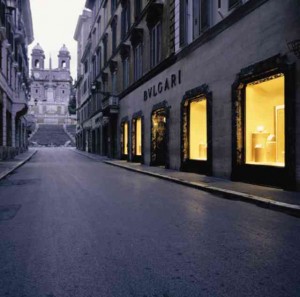
In her autobiographical book, “Elizabeth Taylor: My Love Affair with Jewelry,” the star recalls: “Undeniably, one of the biggest advantages to working on ‘Cleopatra’ in Rome was Bulgari’s little shop. I used to visit Gianni Bulgari in the afternoon and we’d sit… and swap stories.”
In the ’60s, one reached this room through a door in the private courtyard to avoid the paparazzi. This “secret” door, which had been closed for decades, is now restored, after the refurbishing by Marino. The 2014 restoration is the first in a long time.
The Via dei Condotti shop has undergone three substantial changes since it first opened. In 1905, the shop occupied two spaces on the street: numbers 10b and 10c. It had a large display window with two smaller ones to the left, and two narrow windows at either end of the façade, all with a veined marble dado. The shop sign was a wrought-iron Art Nouveau design around a cartouche inscribed “S.BVLGARI.”
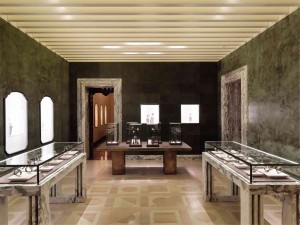
The most important transformation of the façade was between 1933 and 1934. It was entrusted to Florestano Di Fausto, the foremost architect of the era. He transformed the façade with travertine covering, in keeping with the traditions of Roman architecture, and put four large openings for the display windows and a central doorway, all framed by ancient green African marble cornices.
The central doorway was crowned with gilded brass letters spelling “BVLGARI.” The font and the letter “V” replaced the “U”, to follow the ancient Roman inscriptions. This spelling inspired Bulgari’s iconic logo in the 1970s.
The travertine stone slabs, the green African marble cornices and the bronze letters have all been restored to their original state by Marino.
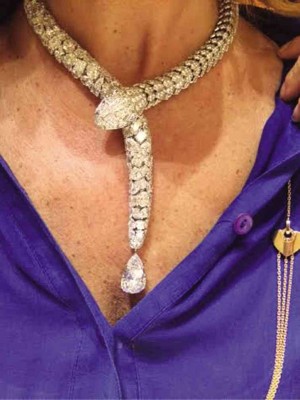
Innovation and tradition
Marino, an artist, collector and architect, undertook the contradicting challenge of transforming and restoring the store. His and his team’s task involved an interplay between innovation, transgression and tradition, according to Bulgari’s account of the project.
Bulgari noted: “Italian modern rationalist architects such as Di Fausto loved combining modern and classical elements of style. This is one of the reasons behind Marino’s special affinity for Di Fausto’s approach.
“Marino’s aim in the front section of the shop was to retain and reinstate the existing decor and character created by Di Fausto. In the inner section, he has unveiled some striking modernist features originally designed by Di Fausto, which for decades had lain hidden behind subsequent refurbishments. Thanks to his unique eclecticism, he has also skillfully integrated the surrounding spaces into a much more homogeneous and aesthetically pleasing ensemble.”
Marble and wood are prominent. “For example, the new marbles were chosen because of their relationship with similar materials used in ancient Rome and in Di Fausto’s design. Similarly, the wood and marble furnishings are the work of Italian designers who have links to Bulgari’s history and Di Fausto’s style…
“The visitor steps inside from Via dei Condotti into a richly decorated elliptical vestibule which has changed little from Di Fausto’s time. The four arched doorways are framed by six twinned ancient African green marble columns topped with gilded bronze composite capitals…
“Gilded crowns adorn the niches; all four are different, chosen in the 1930s for their individual beauty. On the floor, a central red porphyry eight-pointed star inlay is surrounded by cream-colored Botticino marble. The border is gray-red Salomé marble…
“The character of the 1930s décor has also been preserved in the two galleries on either side of the entrance… The gallery to the left of the entrance will showcase Bulgari’s High Jewellery Collection, the one to the right the wide range of diamond-set jewels of the bridal collection…”
New men’s gallery
The store has a new gallery dedicated to men’s watches, where Marino has created a masculine atmosphere, reminiscent of a 19th-century fumoir, or of a gentlemen’s club. Its color palette is dark, ranging from gray and bronze to dark green.
Di Fausto’s glass-topped walkway also has been beautifully restored.
Bulgari explained: “In the 1930s, the vaulted roof of concrete-framed glass blocks made a stark contrast with the more classical style of the front of the store. Ancient Rome, with its fine polychrome marbles and bronze detailing, meets modern rationalist architecture, with the concrete-framed glass vaulting in the gallery… This is what appealed to Marino… He punctuated it with openings lined with Breccia di Seravezza stone, reminiscent of the marvelous ancient green African marble of the façade. The walkway, with its filtered natural light, is now even more spectacular. The result is a magnificent Roman promenade, at the same time both ancient and modern, at the heart of the Bulgari world…”
For the 130th anniversary event that spring evening, a palazzo near the Via dei Condotti store was transformed into a magical setting, with buffet spreads in each room bearing platters and plates designed as jewelry. That was the first time we saw such luscious and ornate food presentations.
That, plus the dramatically lit Spanish Steps, and the restored Bulgari store—all these spelled the magic of Rome’s early spring.
But the Ultimate Temptation Serpenti necklace of over 60 carats of fancy-shaped diamonds and a 12.16-carat drop diamond displayed that evening was what made that early spring ultimately priceless and timeless.

